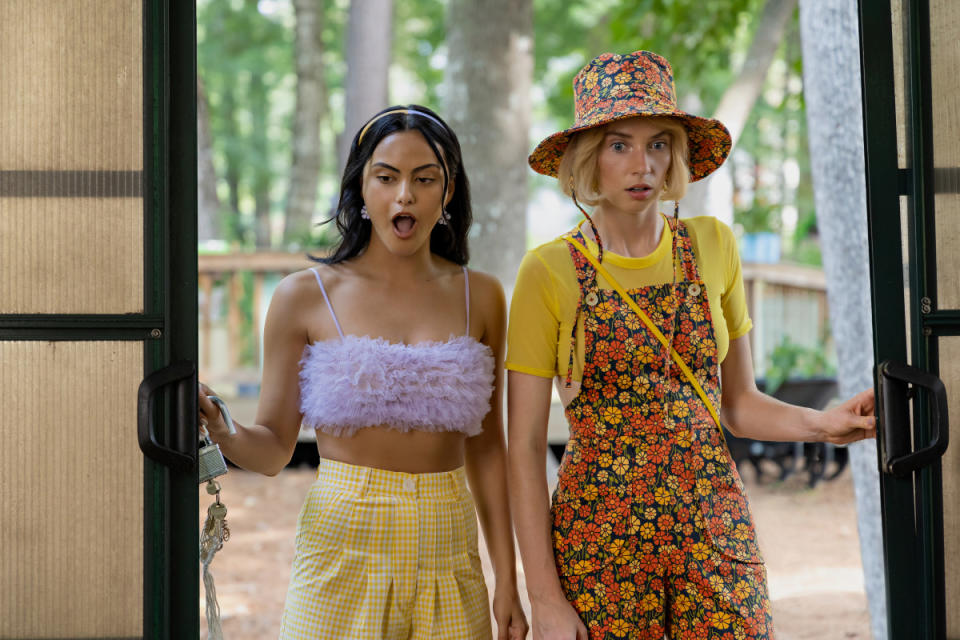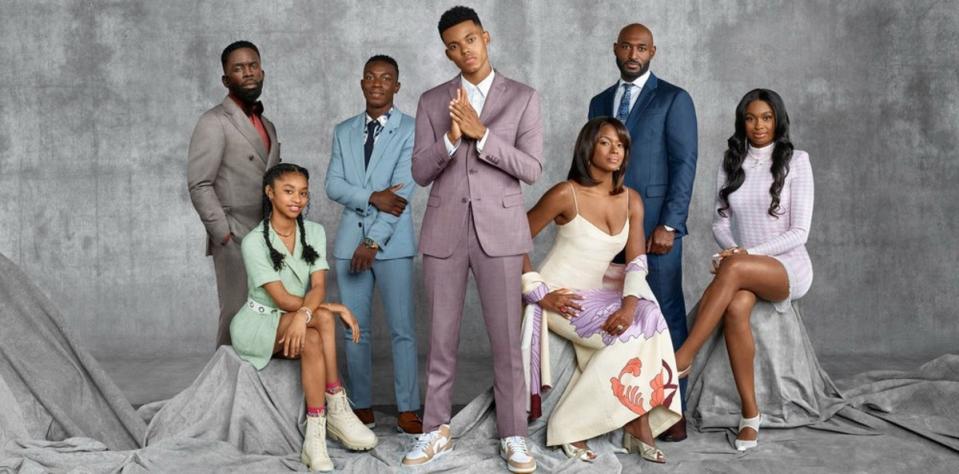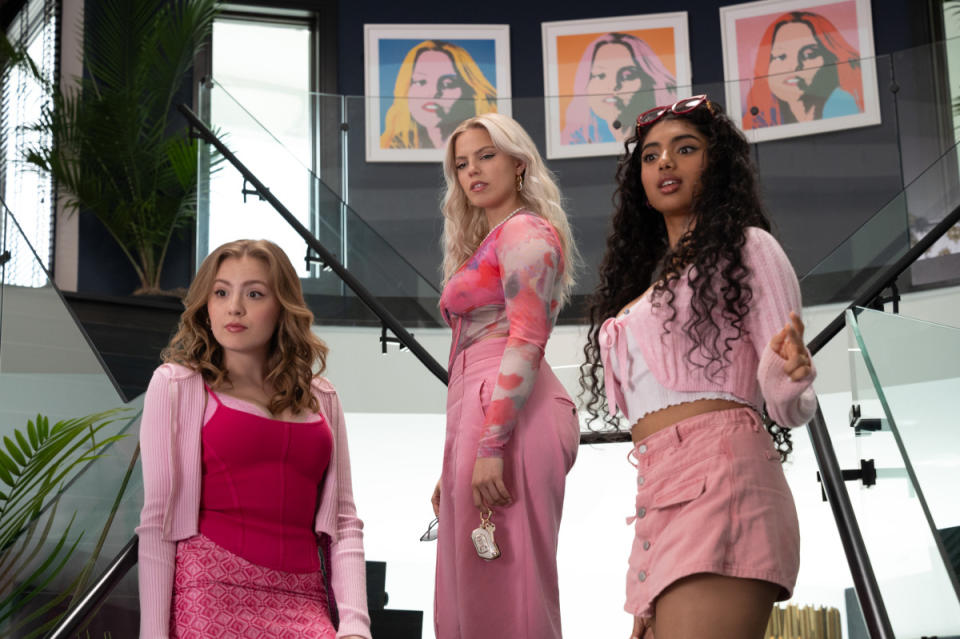How Can Hollywood Most Accurately Capture Gen-Z Style?
Driven by the desire to disrupt the status quo, Generation Z has pushed fashion in recent years by dismantling archaic rules on what's "in" and what's "out." This has, in turn, encouraged a whirlpool of creativity when it comes to how we dress — something Hollywood has struggled to accurately capture. And this generation isn't afraid to speak out when they feel misrepresented in their styling, as made evident by the uproar over the new "Mean Girls" film earlier this year.
Upon the release of the movie musical's trailers, a slew of criticism spread via social media, fueled by the belief that the new characters' styling failed to capture the trend-setting nature of the original film. Many detested that the fashion choices categorized Gen Z as the "sponsored by Shein" generation. (As one TikToker explained it: "When I look at this picture [of the three 'plastics,' it feels] like the designer was a little bit older and was like, 'What does Gen Z wear? We need to modernize the 'Mean Girls' aesthetic.'")
Clearly, reflecting the fashion of Gen Z on screen is easier said than done.
While, historically, fashion trends have remained somewhat unified amongst decades — the '70s, for instance, brought us bell bottoms and tie-dye, while the '80s were all about bright colors and even bolder shoulder pads — Gen Z (born between 1997 and 2012) has become the outlier by rejecting labels and static aesthetics, opting for sartorial choices that combine flair, personality and nostalgia. The most popular trend is often to not follow a singular trend at all and, instead, to concoct a hodgepodge of mix-matched style choices. To Gen Z, being "unfashionable" is fashion.
"Fashion now is a free-for-all — you can wear anything, and it's trendy and cool," says Alana Morshead, costume designer on Netflix's "Do Revenge." "It's not a one-way street anymore. We can mix and match."

Photo: Kim Simms/Courtesy of Netflix
Morshead uses the term "chaos girlie" to describe this disruptive approach to getting dressed, where the final product looks frivolously thrown together, but was in fact meticulously curated with intention. In "Do Revenge," Eleanor (played by Maya Hawke) encapsulates this well. But she differs greatly from how Drea (portrayed by Camila Mendes) is dressed, referencing iconic films like "Jawbreaker," "Clueless" and the original "Mean Girls" in her style choices.
QueenSylvia Akuchie, costume designer on Peacock's "Bel-Air," took a similar approach to Morshead, using "The Fresh Prince of Bel-Air" as the blueprint for the new series, then analyzing the ways those characters would adapt to today's world. She asked herself questions like, "How does a Black family now live in Bel-Air? What does that look like for an artist like Vivian Banks? Or an influencer like Hilary?" Akuchie's styling of Jazz (played by Jordan L. Jones) in particular pulls staple items from across decades into a delicious, bold aesthetic that makes the character instantly recognizable.

Photo: Kwaku Alston/Courtesy of Peacock
Understanding the cultural and societal influences around fashion is an important first step to cracking the code in dressing Gen Z, a generation largely influenced by the communities that surround them, both physical and digital. A wealthy Gen-Z influencer in Bel-Air may not prescribe to the "chaos girlie" aesthetic, but a New York City fashion student likely would. To put it simply, Gen Z has the range, and that range is determined by the external forces they digest on a regular basis.
When costuming "Do Revenge," Morshead relied heavily on female-owned businesses that she would come across on platforms like TikTok, Instagram and Pinterest. (Gen Z are the latter's top growing demographic at 40% of overall users.) Access to inspiration from different cultures across the world — in addition to instantly-viewable imagery of previous fashion trends dating back hundreds of years — has made everything from "Bridgerton-chic" to leather chaps and cowboy boots "on trend" at the same time for Gen Z.
"Gen Z has so many outside influences that no generation has had prior, and that has deeply impacted their fashion choices," Alix Gropper, one half of styling duo Danielle and Alix — which has worked with young stars like Alix Earle — says. "There's so much knowledge and information out there, it's so cool to see how this generation can meld influences from media, movies, TV shows and red carpets to form their own styles and microtrends that have never existed before."

Photo: Jojo Whilden/Paramount © 2023 Paramount Pictures/Courtesy of Paramount
Social media provides inspiration and spurs creativity for Gen Z. Fast fashion then offers the ability to bring these to life in seconds, allowing them to mix and match garments at the speed of light, determining what they love and what they’ll keep in the closet until further notice. "We're in an age where everyone wants to be wearing the next trend [right away] because with social media comes the comparison [game]," says stylist Meghan Stimac, who regularly works with Olivia Ponton. "Everyone wants to make sure that they're at the same level, and [both fast fashion] and social media play big roles in that."
As the most diverse generation to exist, Gen Z's style choices also reflect the cultures and communities they identify with. They refuse to prescribe to a singular notion of "our generation's staple fashion item is this," and instead craft rules and trends based upon their individuality. That's precisely what makes capturing Gen Z in the media so challenging: To accurately do so, a costume designer must deeply research the specifics of what Gen Z community they're trying to capture — is it Los Angeles tweens with the dream of early stardom, East Coast private school students with a love of designer items or (and this is often the trickiest) "middle of America" Gen Z-ers whose access to fashion inspiration is often digital-first?
Akuchie says she puts as much research into a project with Gen-Z characters as she would a period drama, giving each individual the development and depth needed to be brought to life authentically. That includes having conversations with Gen Z-ers themselves, determining the cultural influences for the specific community she's trying to capture and then analyzing how those fit a modern story. It takes more than a singular scroll through TikTok to do this.
There may be certain trends that unite this diverse generation — often fueled by young pop stars, like Olivia Rodrigo — but trends filter out as fast as a scroll through TikTok. Style has become less linear, more chaotic and totally authentic over the years, which makes it impossible to prescribe Gen Z to a singular aesthetic. In a way, this gives costume designers more freedom with their creativity.
Hollywood may never perfectly capture Gen Z's style in one series or movie — and perhaps that doesn't really matter. This generation cannot and will not be defined by a singular trend or aesthetic because, for Gen Z, fashion is expression, and that expression is guided through personal liberation, which looks different on every body and is influenced by factors like race, background, location, status, body type and wealth. Gen Z isn't a monolith, which is precisely why numerous teen-centered productions released from a singular streaming service may all look vastly different. Each is set to capture not Gen Z as a whole, but a specific community or fashion viewpoint within this very-experimental generation.
The one rule Gen Z will always preach? There's no such thing as "one style or size fits all."
Want the latest fashion industry news first? Sign up for our daily newsletter.

